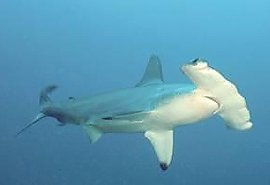
The Hammerhead shark as the name suggests, looks like the shape of a hammer and is easily recognised even at a distance, by the shape of the head.
The eyes are on the outside edges of their wide thick head, and it is beleived that this wide separation of the eyes gives it a wide range of vision.
This large head probably also acts as a wing, improving manoeuvrability.
The Hammerhead Shark is moderately common around the northern parts of New Zealand. This species also normally occurs in warm tropical waters off the coast of Australia and Central America.
They are a solitary, nomadic and migratory fish, though often they can be found swimming together in schools with other hammerheads in water from the surface down to a depth of 80mts or 262ft.
The hammerhead is a dark olive green to brownish grey on the topsides and white on its belly.
It's skin has the same texture as sandpaper, smooth if rubbed one way but rougth the other.
These sharks can grow up to 3.5mts or 11.5ft in length, though some have been known to grow as much as 6mts or 20feet. They can weigh anywhere from 225-453kgs or 500-1,000lbs.
Appart from their distinct head Hammerhead sharks have two dorsal fins and an anal fin, the first dorsal fin is very high and curved, the second dorsal and pelvic fins also high and with deeply concave rear margins.
They have five gill slits (these gills allow the shark to breathe by extracting oxygen from the water and then pushing it over the gill slits), Their mouth is behind their eyes. Part of their anatomy they have what we call a spiral intestinal valve. This spiral intestinal valve is like a spiral staircase. The food passes through this valve extremely slowly. This slow rate means that hammerheads cannot feed often.
They have rows of triangular shaped teeth with hundreds of serrations on each tooth.
Hammerheads are fierce predators that use their great sense of smell to find prey. Their main diet are other fish including rays and other sharks, sometimes octopuses, squid and crustaceans.
Stingrays seem to be a consistent favorite with hammerheads. They use their hammer heads to pin the ray down to the ocean bottom wile they take bites from it's wings. Scientists once found a hammerhead with nearly 100 stingray spines stuck in its mouth and gills.
Hammerhead shark's eggs are fertilized inside the female's body. The male shark has "claspers," extensions of the pelvic fins that are used to transfer sperm to the female and fertilize her eggs.
Female Hammerheads produce between 13-42 young. Its young are born alive with their heads bent backwards so they don't get stuck in the birth canal.
These young are around 56-70 cm or 2ft long. These young pups are born with a full set of teeth and are fully ready to take care of themselves.
The eggs hatch inside the female's body and the babies are fed by a placenta which transfers nourishment from the mother to the babies (via an umbilical cord which is connected to the baby shark between the pectoral fins).
The Hammerhead shark have a very slow growth rate and may live 20 to 30 years.